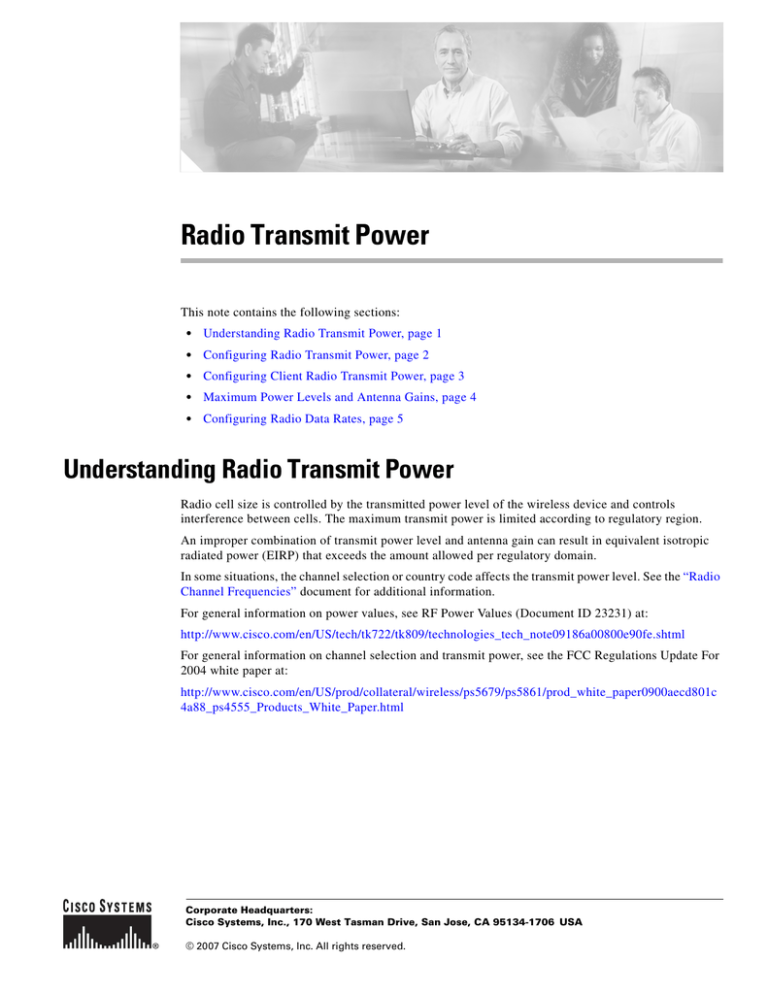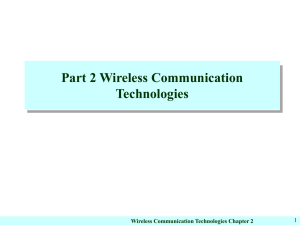
Radio Transmit Power
This note contains the following sections:
•
Understanding Radio Transmit Power, page 1
•
Configuring Radio Transmit Power, page 2
•
Configuring Client Radio Transmit Power, page 3
•
Maximum Power Levels and Antenna Gains, page 4
•
Configuring Radio Data Rates, page 5
Understanding Radio Transmit Power
Radio cell size is controlled by the transmitted power level of the wireless device and controls
interference between cells. The maximum transmit power is limited according to regulatory region.
An improper combination of transmit power level and antenna gain can result in equivalent isotropic
radiated power (EIRP) that exceeds the amount allowed per regulatory domain.
In some situations, the channel selection or country code affects the transmit power level. See the “Radio
Channel Frequencies” document for additional information.
For general information on power values, see RF Power Values (Document ID 23231) at:
http://www.cisco.com/en/US/tech/tk722/tk809/technologies_tech_note09186a00800e90fe.shtml
For general information on channel selection and transmit power, see the FCC Regulations Update For
2004 white paper at:
http://www.cisco.com/en/US/prod/collateral/wireless/ps5679/ps5861/prod_white_paper0900aecd801c
4a88_ps4555_Products_White_Paper.html
Corporate Headquarters:
Cisco Systems, Inc., 170 West Tasman Drive, San Jose, CA 95134-1706 USA
© 2007 Cisco Systems, Inc. All rights reserved.
Configuring Radio Transmit Power
Determine the Radio Type
Determine the radio type to establish the frequency range and power setting of the radio. Use the show
controllers dot11Radio command to show the radio type, frequency, and current channel for the
wireless device. For example:
WD#show controllers dot11Radio 0
interface Dot11Radio0
!
Radio AIR-AP1242GA, Base Address 0014.1b58.08f
Version 5.80.12
Serial number: GAM09200992
Number of supported simultaneous BSSID on Dot1
Carrier Set: Americas (US)
DFS Required: No
!
Current Frequency: 2412 MHz Channel 1
! AIR-AP1242GA radio type shown
! Domain
! DFS requirement
! Frequency
Configuring Radio Transmit Power
To set the transmit power on the wireless device radio to one of the power levels allowed in your
regulatory domain, use the power local interface command.
For all 802.11b 2.4 GHz radios, the settings are in mW:
power local[1 | 5 | 20 | 30 | 50 | 100 | maximum]
For 802.11g, 2.4 GHz radios where the settings are in mW:
power local{cck | ofdm} [1 | 5 | 20 | 30 | 50 | 100 | maximum]
For the 802.11g, 2.4 GHz radio where the settings are in dBm:
power local{cck | ofdm} [1 | 2 | 5 | 8 | 11 | 14 | 16 | 17 | 20 | maximum]
For 802.11a, 5 GHz radios or 4.9 GHz radios where the settings are in mW:
power local{cck | ofdm} [5 | 10 | 20 | 40 | maximum]
The maximum power level for a 4.9 GHz (US Only, Public Safety) radio is 40 mW.
For 802.11a, 5 GHz radio where the settings are in dBm:
power local{cck | ofdm} [1 | 2 | 5 | 8 | 11 | 14 | 16 | 17 | maximum]
Complementary Code Keying (CCK) is supported by 802.11b and 802.11g devices. Orthogonal
Frequency Division Multiplexing (OFDM) is supported by 802.11g and 802.11a devices.
Note
The structure of this command is determined by the radio in the wireless device and the settings
allowed in your regulatory domain. To display the options for your wireless infrastructure device
running your image, use the power local ? command in privileged EXEC mode.
Use the no form of the power command to return the power setting to maximum, the default setting.
Radio Transmit Power
2
OL-14978-01
Configuring Client Radio Transmit Power
Configuring Client Radio Transmit Power
The transmit power level of Cisco clients can be controlled by a Cisco wireless infrastructure device.
The client software chooses the actual transmit power level, choosing between the lower of the access
point value and the locally configured value.
To set the transmit power on your wireless device radio, use the power client command.
For all 802.11b 2.4 GHz radios, the settings are in mW:
power client [1 | 5 | 20 | 30 | 50 | 100 | maximum]
For 802.11g, 2.4 GHz radios where the settings are in mW:
power client [1 | 5 | 20 | 30 | 50 | 100 | maximum]
For the 802.11g, 2.4 GHz radio where the settings are in dBm:
power client [1 | 2 | 5 | 8 | 11 | 14 | 16 | 17 | 20 | maximum]
For 802.11a, 5 GHz radios where the settings are in mW:
power client [5 | 10 | 20 | 40 | maximum]
For 802.11a, 5 GHz radio where the settings are in dBm:
power client [1 | 2 | 5 | 8 | 11 | 14 | 16 | 17 | maximum]
Sets the maximum power level allowed on client devices that associate to the wireless device.
Use the no form of the command to return the power setting to maximum, the default setting.
Table 1
mW
mW DBm Power Conversion Table
1
DBm -1
2
3
4
5
6
8
10
12
15
20
25
30
40
50
60
80
100
2
5
6
7
8
9
10
11
12
13
14
15
16
17
18
19
20
Note
Aironet extensions must be enabled to limit the power level on associated client devices. Aironet
extensions are enabled by default.
Radio Transmit Power
OL-14978-01
3
Maximum Power Levels and Antenna Gains
Maximum Power Levels and Antenna Gains
IEEE 802.11g (2.4 GHz Band)
Table 2 indicates the maximum power levels and antenna gains allowed for the 2.4 GHz radios in most
regulatory domains. We recommend that you check your local regulations with the appropriate agencies.
Table 2
Maximum Power Levels Per Antenna Gain for IEEE 802.11g
Regulatory Domain
Americas (–A)
(4 W EIRP maximum)
EMEA (–E) and Israel(-I)
(100 mW EIRP maximum)
Japan (-J)
(10 mW/MHz EIRP maximum)
Maximum Power Level (mW)
Antenna Gain
(dBi)
CCK
OFDM
2.2
100
30
6
100
30
6.5
100
30
10
100
30
13.5
100
30
15
50
20
21
20
10
2.2
50
30
6
30
10
6.5
20
10
10
10
5
13.5
5
5
15
5
1
21
1
—
2.2
5
5
6
5
5
6.5
5
5
10
5
5
13.5
5
5
15
5
5
21
5
5
Radio Transmit Power
4
OL-14978-01
Configuring Radio Data Rates
Configuring Radio Data Rates
Client devices are required to support at least one basic data rate or they are not be allowed to associate
with the wireless device. For example, if the speed of the wireless device is set to basic-1.0, the client
must support a 1.0 Mbps transmission rate or it will not be allowed to associate with the wireless device.
If the speed of the wireless device is set to basic-1.0 and basic-6.0, the client must support a 1.0 Mbps
or a 6.0 Mbps transmission rate or it will not be allowed to associate with the wireless device.
The wireless device always attempts to begin data transmission at the highest basic data rate. For
example, if the client device supports both t a 1.0 Mbps and a 6.0 Mbps transmission rate, both of the
devices use the higher 6.0 Mbps transmission rate.
Client devices are allowed to transmit at other data rates, depending on the configuration. If the client
device supports the basic data rate and due to environmental conditions, the wireless and client devices
can transmit at a higher data rate, the devices will transmit unicast packets at the highest allowed data
rate; multicast packets are always sent at the highest basic data rate.
If, due to environmental factors such as obstacles or interference, the wireless device cannot transmit
data at the highest basic data rate, the wireless device steps the speed down to the highest rate that allows
it to transmit data.
The wireless device can be configured to automatically transmit at the data rate that optimizes either the
range of the transmission or the throughput of the data. Use the range keyword to optimize the wireless
device for the best range. The wireless device sets the basic rate to basic-1.0 and all other rates are
allowed. Use the throughput keyword to optimize the wireless device for maximum data throughput.
The wireless device sets all data rates to basic.
Radio Transmit Power
OL-14978-01
5
Configuring Radio Data Rates
speed Command
To manage the data rates on wireless devices, use the speed datarate interface command.
Table 3 shows the data rate settings for the speed command.
Table 3
Data Rates for speed Command Keywords
2.4 GHz 802.11b
Radio
2.4 GHz 802.11g
Radio
4.9 GHz at
4.9 GHz at 5 MHz 10 MHz
rate
basic-1.0,
basic-2.0,
basic-5.0,
basic-11.0, 1.0,
2.0, 5.0, 11.0
basic-1.0,
basic-2.0,
basic-5.0,
basic-11.0,
basic-12.0,
basic-18.0,
basic-24.0,
basic-36.0,
basic-48.0,
basic-54.0,
1.0, 2.0, 5.0,
11.0, 12.0, 18.0,
24.0, 36.0, 48.0,
54.0
basic-1.5,
basic-2.25,
basic-3.0,
basic-4.5,
basic-9.0,
basic-12.0,
basic-13.5,
1.5, 2.25, 3.0,
4.5, 9.0, 12.0,
13.5
basic-3.0,
basic-4.5,
basic-6.0,
basic-9.0,
basic-12.0,
basic-18.0,
basic-24.0,
basic-27.0,
3.0, 4.5, 6.0, 9.0,
12.0, 18.0, 24.0,
27.0
basic-6.0,
basic-9.0,
basic-12.0,
basic-18.0,
basic-24.0,
basic-36.0,
basic-48.0,
basic-54.0,
6.0, 9.0, 12.0,
18.0, 24.0, 36.0,
48.0, 54.0
default
The default
keyword is not
supported on
802.11b radios.
basic-1.0,
basic-2.0,
basic-5.5,
basic-11.0, 6.0,
9.0, 12.0, 18.0,
24.0, 36.0, 48.0,
54.0
basic-1.5, 2.25,
basic-3.0, 4.5,
basic-6.0, 9.0,
12.0, 13.5
basic-3.0, 4.5,
basic-6.0, 9.0,
basic-12.0, 18.0,
24.0, 27.0
basic-6.0, 9.0,
basic-12.0, 18.0,
basic-24.0, 36.0,
48.0, 54.0
range
basic-1.0,
2.0, 5.0, 11.0
basic-1.5, 2.25, basic-3.0, 4.5,
basic-1.0,
3.0, 4.5, 6.0, 9.0, 6.0, 9.0, 12.0,
2.0, 5.0, 11.0,
18.0, 24.0, 27.0
12.0, 18.0, 24.0, 12.0, 13.5
36.0, 48.0, 54.0
basic-6.0, 9.0,
12.0, 18.0, 24.0,
36.0, 48.0, 54.0
no speed
basic-1.0,
2.0, 5.0, 11.0
1.5, 2.25, 3.0,
basic-1.0,
4.5, 6.0, 9.0,
2.0, 5.0, 11.0,
12.0, 18.0, 24.0, 12.0, 13.5
36.0, 48.0, 54.0
Keyword
4.9 GHz at
20 MHz
3.0, 4.5, 6.0, 9.0, 6.0, 9.0, 12.0,
12.0, 18.0, 24.0, 18.0, 24.0, 36.0,
27.0
48.0, 54.0
Radio Transmit Power
6
OL-14978-01
Configuring Radio Data Rates
Table 3
Keyword
throughput
throughput
ofdm
Data Rates for speed Command Keywords
2.4 GHz 802.11b
Radio
2.4 GHz 802.11g
Radio
4.9 GHz at
4.9 GHz at 5 MHz 10 MHz
basic-1.0,
basic-2.0,
basic-5.0,
basic-11.0
basic-1.0,
basic-2.0,
basic-5.0,
basic-11.0,
basic-12.0,
basic-18.0,
basic-24.0,
basic-36.0,
basic-48.0,
basic-54.0
basic-1.5,
basic-2.25,
basic-3.0,
basic-4.5,
basic-6.0,
basic-9.0, basic12.0, basic-13.5
basic-3.0,
basic-4.5,
basic-6.0,
basic-9.0,
basic-12.0,
basic-18.0,
basic-24.0,
basic-27.0
4.9 GHz at
20 MHz
basic-6.0,
basic-9.0,
basic-12.0,
basic-18.0,
basic-24.0,
basic-36.0,
basic-48.0,
basic-54.0
1
Sets OFDM
rates to
basic-6.0,
basic-9.0,
basic-12.0,
basic-18.0,
basic-24.0,
basic-36.0 and
disables CCK
data rates 1.0,
2.0, 5.5, 11.0.
1. Disables 802.11b protection mechanisms, prevents 802.11b clients from associating to the wireless device, and maximizes
throughput for 802.11g clients.
speed Command Examples
This example sets a 5 GHz radio for basic-6.0 and basic-9.0 service only. Client devices must support
basic-6.0 and basic-9.0 service or they will not be able to associate.
WD# configure terminal
WD(config)# interface dot11radio 1
WD(config-if)# speed basic-6.0 basic-9.0
WD(config-if)# end
This example sets a 2.4 GHz radio for basic-1.0 service and allows all other data rates by using the no
form of the command. Multicast packets are transmitted at 1 Mbps. Unicast packets are transmitted at
the highest allowed data rate. Client devices must support basic-1.0 service or they will not be able to
associate.
WD# configure terminal
WD(config)# interface dot11radio 1
WD(config-if)# no speed
WD(config-if)# end
This example sets a 2.4 GHz radio to serve only 802.11g client devices by using the Orthogonal
frequency division multiplexing (OFDM) keyword throughput ofdm.
WD# configure terminal
WD(config)# interface dot11radio 0
WD(config-if)# speed throughput ofdm
WD(config-if)# end
Radio Transmit Power
OL-14978-01
7
Configuring Radio Data Rates
Verify Settings
Use the show controller dot11radio command to display the data rates for the speed command and the
default keyword.
With the speed command set to the default value for a 2.4 GHz, 802.11g radio, the show controller
dot11radio command displays the following:
WD# show controller dot11Radio0
interface Dot11Radio0
Radio ATHEROS AR5212, Address 000e.9bb0.7360, BBlock version
0.01, Software version 3.00.0 Serial number: FOC05120075
Carrier Set: Americas (US) Current Frequency: 2432 Mhz
Channel 5 Allowed Frequencies: 2412(1) 2417(2) 2422(3) 2427(4) 2432(5) 2437(6) 2442(7)
2447(8) 2452(9) 2457(10)
2462(11) Current CCK Power: 20 dBm Allowed CCK Power Levels: 7 10 13 15 17 20 Current OFDM
Power: 17 dBm Allowed OFDM
Power Levels: 7 10 13 15 17 ERP settings: protection mechanisms, non-ERP present.
Neighbors in non-erp mode:
0040.96a2.7d70 0013.5f0c.2961 000c.8548.d9b9 0007.50ca.6885
000e.9b91.cb82 0013.5f0c.2960 0013.5f0c.2962 000d.9701.212b
000e.9ba1.cba4 0014.a40b.b4f0
Current Rates: basic-1.0 basic-2.0 basic-5.5 6.0 9.0 basic-11.0 12.0 18.0 24.0 36.0 48.0
54.0
Allowed Rates: 1.0 2.0 5.5 6.0 9.0 11.0 12.0 18.0 24.0 36.0 48.0 54.0
Best Range Rates: basic-1.0 2.0 5.5 6.0 9.0 11.0 12.0 18.0 24.0 36.0 48.0 54.0
Best Throughput Rates: basic-1.0 basic-2.0 basic-5.5 basic-6.0 basic-9.0 basic-11.0
basic-12.0 basic-18.0 basic-24.0 basic-36.0 basic-48.0 basic-54.0
With the no speed command set on a 2.4 GHz, 802.11g radio,
WD# configure terminal
WD(config)# interface dot11 0
WD(config-if)# no speed
WD(config-if)# end
the show controller dot11radio command displays the following:
WD# show controller dot11Radio 0
interface Dot11Radio0
Radio ATHEROS AR5212, Address 000e.9bb0.7360, BBlock version
0.01, Software version 3.00.0 Serial number: FOC05120075
Carrier Set: Americas (US) Current Frequency: 2432 Mhz
Channel 5 Allowed Frequencies: 2412(1) 2417(2) 2422(3)
2427(4) 2432(5) 2437(6) 2442(7) 2447(8) 2452(9) 2457(10)
2462(11) Current CCK Power: 20 dBm Allowed CCK Power Levels:
7 10 13 15 17 20 Current OFDM Power: 17 dBm Allowed OFDM
Power Levels: 7 10 13 15 17 ERP settings: protection
mechanisms, non-ERP present.
Neighbors in non-erp mode:
000e.9b91.cb82 000e.9ba1.cba4 0040.96a2.7d70 000d.9701.212b
0014.a40b.b4f0
Current Rates: basic-1.0 2.0 5.5 6.0 9.0 11.0 12.0 18.0 24.0 36.0 48.0 54.0
Allowed Rates: 1.0 2.0 5.5 6.0 9.0 11.0 12.0 18.0 24.0 36.0 48.0 54.0
Best Range Rates: basic-1.0 2.0 5.5 6.0 9.0 11.0 12.0 18.0 24.0 36.0 48.0 54.0
Best Throughput Rates: basic-1.0 basic-2.0 basic-5.5 basic-6.0 basic-9.0 basic-11.0
basic-12.0 basic-18.0 basic-24.0 basic-36.0 basic-48.0 basic-54.0
Default Rates: basic-1.0 basic-2.0 basic-5.5 6.0 9.0 basic-11.0 12.0 18.0 24.0 36.0 48.0
54.0
Radio Transmit Power
8
OL-14978-01





